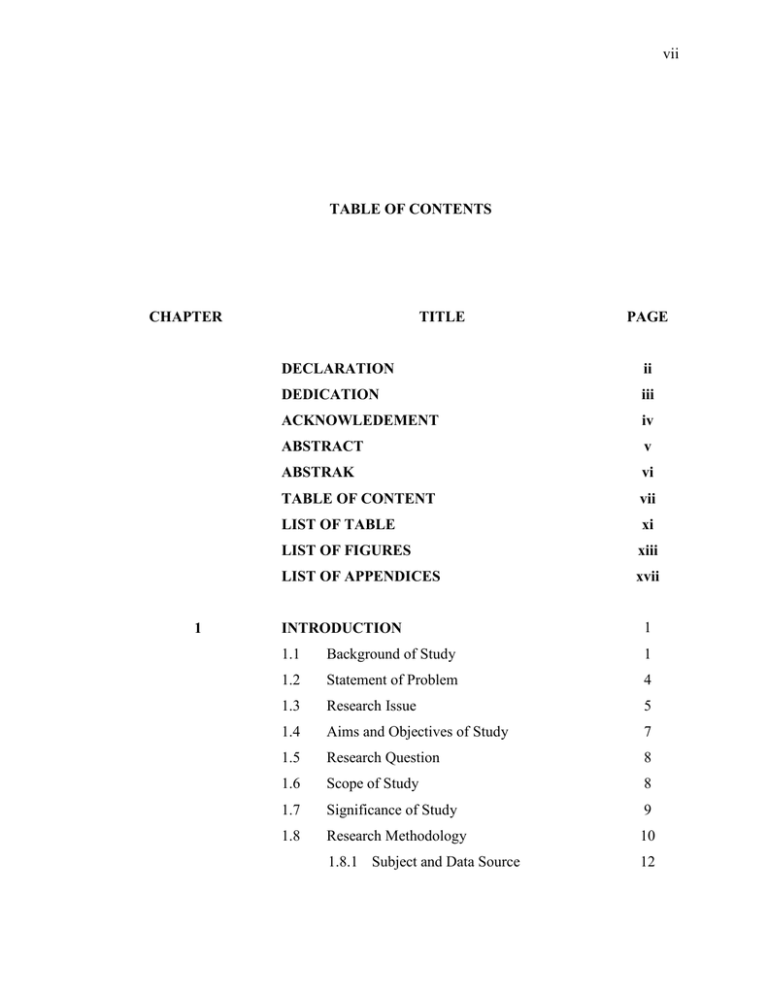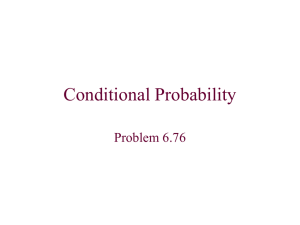vii TABLE OF CONTENTS CHAPTER
advertisement

vii TABLE OF CONTENTS CHAPTER 1 TITLE PAGE DECLARATION ii DEDICATION iii ACKNOWLEDEMENT iv ABSTRACT v ABSTRAK vi TABLE OF CONTENT vii LIST OF TABLE xi LIST OF FIGURES xiii LIST OF APPENDICES xvii INTRODUCTION 1 1.1 Background of Study 1 1.2 Statement of Problem 4 1.3 Research Issue 5 1.4 Aims and Objectives of Study 7 1.5 Research Question 8 1.6 Scope of Study 8 1.7 Significance of Study 9 1.8 Research Methodology 10 1.8.1 Subject and Data Source 12 viii 1.8.1 Subject and Data Source 1.8.1.1 Primary Data 12 1.8.1.2 Secondary Data 13 1.8.2 Data Analysis Technique 14 Anticipated Finding 16 LITERATURE REVIEW 18 2.1 Introduction 18 2.2 Urban Space and Microclimate 19 2.3 Terminology and Definition 21 2.3.1 21 1.9 2 12 Outdoor Space 2.3.2. Street 2.3.2.1 Street as Channel Movement 26 2.3.2.2 Street as Social Space 27 2.3.2.3 Street as Commercial Space 28 2.3.2.4 Street as Political Space 28 2.3.2.5 Street as Cultural Space 28 Pedestrian Mall 29 Environment Behavioral Study 33 2.4.1 Observing Environmental Behavior 37 2.4.2 Pedestrian Counting and Observation 39 2.4.3 Recording Devices 41 2.3.3 2.4 2.5 22 Urban Shade 43 2.5.1 44 Buildings and Trees Shade, and Solar Radiation 2.5.2 2.6 Urban Blocks as Shade Device Summary 46 48 ix 3 EXISTING CONDITION OF THE CASE 50 STUDY AND METHODOLOGY 3.1 Introduction 50 3.1.1 51 Singapore Urbanization and Microclimate 3.1.2 3.2 3.1.1.1 Singapore Urbanization 51 3.1.1.2 Singapore Microclimate 53 Orchard Road Profile 55 3.1.2.1 The Form of Orchard Road 60 3.1.2.2 The Pedestrian Mall 63 A Review of Master Plan 64 3.2.1 65 Existing Spatial Arrangement of Neighborhood 3.2.2 Existing Spatial Arrangement of 71 Building Usage Pattern 3.2.3 Existing Pathway/Pedestrian Mall 75 3.3 Pilot Survey 77 3.4. Information Obtained from the Pilot Survey 79 3.4.1 The Method of Measurement 79 3.4.2 The Activity Observation Results 80 3.5 Methodology and Procedures 81 3.5.1 The Variables 82 3.5.1.1 Observation to Inventory 82 Shade Variables 3.5.1.2 People’s Activity as 84 Dependent Variables 3.5.2 Instrumentation 85 3.5.3 Measurement Procedures 86 3.5.3.1 Shade and Typology Analysis 86 x 3.5.3.2 Counting the Behavior 93 Characteristics 3.5.4 3.6 4 Data Analysis Technique Summary 94 99 DATA ANALYSIS 100 4.1 Introduction 100 4.2 Terminology and Definitions 101 4.3 Typology of Outdoor Spaces 101 4.3.1 Orientation of Outdoor Spaces 102 4.3.1.1 Sample Area 1 (SA-1) 103 4.3.1.2 Sample Area 2 (SA-2) 104 4.3.1.3 Sample Area 3 (SA-3) 105 4.3.1.4 Sample Area 4 and 5 (SA-4 106 and SA-5) 4.3.2 Geometry of Outdoor Spaces 108 4.3.2.1 Outdoor on the Side 108 4.3.2.2 Outdoor Surrounded by 111 Buildings 4.4 Shade Pattern Analysis 113 4.4.1 124 The Photographic Survey on People Activities 4.4.2 4.5 4.6 4.7 Summary of Shade Analysis 131 Behavioral Characteristic 132 4.5.1 Period I 134 4.5.2 Period II 138 Correlation and Regression Analysis 143 4.6.1 Result 144 4.6.2 Output Analysis 145 Chapter Summary 147 xi 5 CONCLUSION AND RECOMENDATION 149 5.1 Introduction 149 5.2 Summary of the Findings 150 5.3 Suggestion for Further Studies 153 5.4 Conclusion 154 156-162 BIBLIOGRAPHY Appendices A-H 160-181 xi LIST OF TABLES TABLE NO. TITLE PAGE 2.1 Street as a Channel Movement 26 2.2 Street as Social Space 27 2.3 Elements in Environmental Behavior Observation 36 2.4 Type of Activities can be expected in the public street 38 2.5 Type of user groups can be expected to use on the 39 public spaces 2.6 Elements on the studied site 43 3.1 Daylight Saving in Singapore (January 10, 2009) 54 3.2 Singapore Solar Energy and Surface Meteorology 54 3.3 Inventory of The Building Usage within The Study 73 Area 3.4 Observation Schedule 93 3.5 Definition of Operational Variables 99 4.1 Time Period of Field Investigation (randomly sampled) 113 4.2 Shade Pattern of SA-1 related to the Time Period 114 4.3 Shade Density of SA-1, Period I 115 4.4 Shade Density of SA-1, Period II 116 4.5 Shade Pattern of SA-2 related to Time Period 117 4.6 Shade Density of SA-2 118 xii 4.7 Shade Pattern of SA-3 related to The Time Period 119 4.8 Shade Pattern of SA-4 related to the Time Period 120 4.9 Shade Pattern of SA-5 related to the Time Period 121 4.10 Shade Density of SA-3 122 4.11 Shade Density of SA-4 122 4.12 Shade Density of SA-5 123 4.13 Density of Activity in Period I, Measuring between 135 10am to 11am 4.14 Summary on Density of Activity in Period I. 135 Measuring between 10am to 11am 4.15 Density of Activity in Period II. Measuring between 138 2pm to 3pm 4.16 Summary on Density of Activity in Period II 139 4.17 Codes and Definition of Operational Variables 142 4.18 Result of Regression Analysis to Shade and Frequency 145 of Human Activities 4.19 Result of T-Test 146 xiii LIST OF FIGURES FIGURE NO. TITLE PAGE 1.1 Stage 1. Flow Chart of Research Design 12 1.2 Stage 2. Flow Chart of Data Analysis 14 1.3 Stage 3. Flow Chart of Data Collection 16 2.1 Ratio of Streetscape; Comparison of Distance (D) and 24 Height (H) of Adjacent Building 2.2 Ratio of Streetscape; Comparison of Width (W) and 24 Height (H) 2.3 Perception in Streetscape Characteristic According to 25 Pedestrians and Motorists 2.4 Environment-Behavior Research 35 2.5 Solar Azimuth and Altitude Angles in Auckland 46 3.1 3 Dimensional View of Singapore City Central 53 3.2 Singapore Sun path Diagram Taken on January 10, 55 2009 3.3 3 Dimensional View of Orchard Road 56 xiv 3.4 The Three-Zones Concept of Orchard Road 59 3.5 Streetscape of Orchard Road (Existing Condition) 60 3.6 Sign Board of Pedestrian Crossing no Allowed 61 3.7 Section of Orchard Road Streetscape (existing 62 condition) 3.8 Appearance of Pedestrian Mall (southern side) 63 3.9 Appearance of Pedestrian Mall (northern side) 63 3.10 2 Dimensional Plan of Urban Geometry at Study Area 66 3.11 Building Height Guide Line at Study Area 67 3.12 Actual Condition of the Building Height at Study Area 68 3.13 The Existing Arrangement of Angsana Trees within 69 Study Area 3.14 Angsana Trees at South side and North side along the 70 Orchard Road 3.15 The Building Usage Pattern within the Study Area 72 (existing condition) 3.16 Existing Condition of Services within Study Area 74 3.17 The Pedestrian Mall within Study Area 75 3.18 Urban Canyon, Ratio between Width and Height 76 (W/H) of the Pedestrian Mall 3.19 Method for Outdoor Spaces to Inventory and 83 Identification 3.20 The 3D Model of Building Blocks Arrangement in the 89 Study Area Generated through Computer Software 3.21 Orientation Typologies of Outdoors 91 3.22 Geometry Typologies of Outdoors 92 3.23 Positive and Negative Correlation Coefficient 98 4.1 Key Plan of Sample Spaces 102 4.2 Orientation Typology of SA-1 104 4.3 Orientation Typology of SA-2 105 xv 4.4 Orientation Typology of SA-3 106 4.5 Orientation Typology of SA-4 and SA-5 107 4.6 Geometry Typology of SA-1 109 4.7 Building Block Geometry of SA-1 109 4.8 Geometry Typology of SA-2 110 4.9 Building block Geometry of SA-2 110 4.10 Geometry Typology of SA-3 111 4.11 Geometry Typology of SA-4 and SA-5 111 4.12 Building Block Geometry of SA-3 112 4.13 Building Block Geometry of SA-4 and SA-5 112 4.14 Sky View Factor 113 4.15 The Level of Shade Density among Sample Spaces 124 4.16 Photographic Survey on SA-1 (January 13, 2009) 127 4.17 Photographic Survey on SA-2 (January 13, 2009) 128 4.18 Photographic Survey on SA-3 (January 13, 2009) 129 4.19 Photographic Survey on SA-4 and SA-5 (January 13, 130 2009) 4.20 Shade Density of each Sample according to Hourly in 131 Day 4.21 Sum of Shade Density by Hourly in Day 132 4.22 Density of each Activity (person/hour) 136 4.23 Density of each Activity among Sample Areas 137 (person/hour) in Period I 4.24 Density of each Activity among Sample Areas in 137 Period I 4.25 Density of each Activity (person/hour) in Period II on 139 SA-1 to SA-4 4.26 Density of Each Activity (person/hour) in Period II on 140 SA-5 4.27 Density of each Activity among Sample Areas 140 xvi (person/hour) in Period II 4.28 Illustration of Density of each Activity among Sample 141 Areas in Period II 4.29 Comparison Density of Activity among Sample Spaces 142 5.1 The Level of Shade Density among Sample Spaces 150 5.2 Physical Setting of SA-5 151 xvii LIST OF APPENDICES APPENDICES TITLE PAGE A Orchard Road Plan 163 B Sample Areas Plan 164 C Pedestrian Mall Plan 165 D Pedestrian Connection Plan E 166 0 Hourly Dry Bulb Temperature (C ) of Changi Met 167 Station in Singapore F The Measurement People’s Activities and Walking 168 Intensity on Sample Spaces G The Measurement of Shade Density on Sample Spaces 175 H Correlation and Regression Analysis between Shades 178 and Activities


